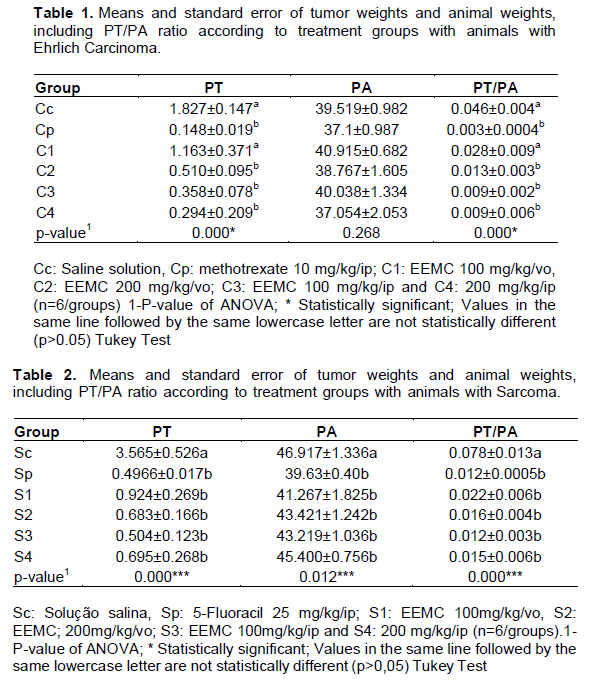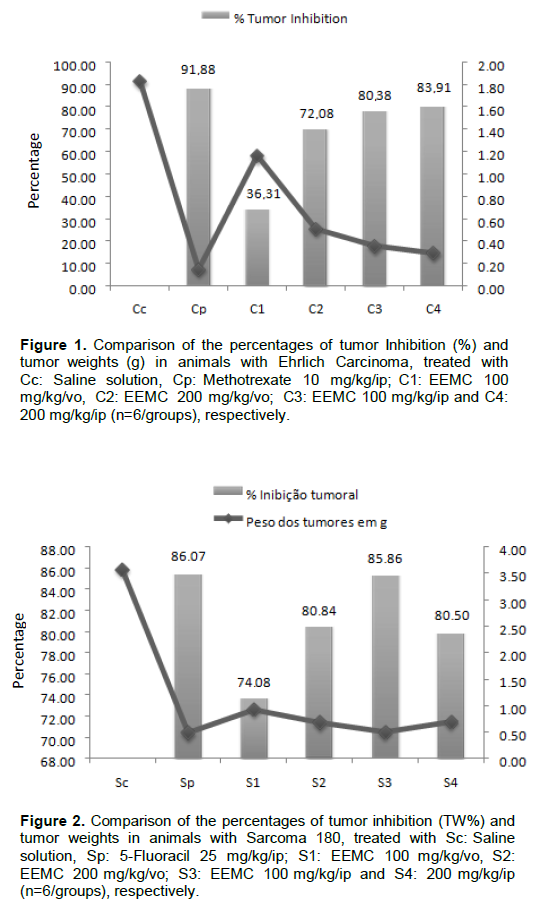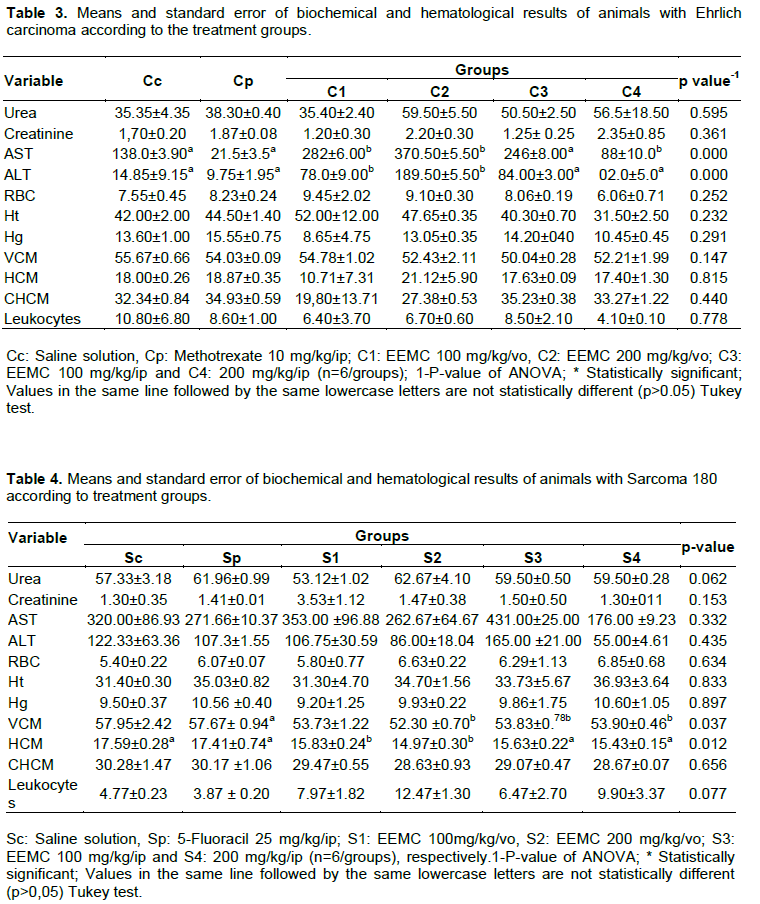Given the concern about to the high incidence of cancer and low specificity of available antineoplasic drugs, Morinda citrifolia Linn is a tropical plant species with wide distribution, which had its consumption widely spread both because it is a source of nutrients and its phytotherapic properties as well as for its adaptation. The potential of tumor inhibition was done in vivo against Ehrlich Carcinoma and Sarcoma 180, a sharp reduction of weight of the tumors was obtained in comparison with the control group. The inhibition of tumor growth compared to Ehrlich carcinoma was more prominent in the dose 200 mg/kg/ip with inhibition percentage of 83.91%, on the other hand against Sarcoma 180. The greatest potential inhibition was detected at the dose of 100 mg/kg/ip with a percentage of 85.86%. Measurements of biochemical and hematological markers did not suffer drastic changes. Thus, the ethanol extract of M. citrifolia Linn showed promising antitumor effects towards the used varieties.
Considered a problem of public health by 2030, the global burden will be 21.4 million new cancer cases and 13.2 million cancer deaths as a result of growth and population aging, the reduction in infant mortality and deaths from infectious diseases in development countries (Inca, 2013).
The use of plants with medical purposes is common, mainly in populations with low acquisition power, due to its accessible price. M. citrifolia Linn. is a tropical plant belonging to the family of Rubiaceae, it is characterized for being a brush of low to medium size (3 to 10 m tall) and is largely distributed between the tropics, although it is native from southwest of Asia and Australia, and it has a history of use not only nutritional but also to promote health (Chan-blanco et al., 2006).
The content, composition and post harvest processes adopted in the preparation of M. citrifolia L juice, suffer great degree of variability (West et al., 2006). A commercial source M. citrifolia L juice, originated from French Polynesia, where it has been used as food and for medicinal purposes for over 2000 years; was approved as food by the European Union, European Comission, 2003. For M. citrifolia L species has been assigned properties as antimicrobial, antipsychotic, antitumor, vasodilatory, antioxidant, among others (HIrazumi and Furusawa, 1999; Correia, 2011, Pandy et al., 2012; Brett et al., 2012; Ma et al., 2013).
Considering the fact that the location at which the plant grows is decisive for the presence and concentration of metabolites which are responsible for their biological properties and the high adaptability of said species to various soil types and climatic regions, it is important to evaluate the potential tumor inhibition of the fruit of M. citrifolia L.
Collection and extraction of plan
The fresh fruits of M. citrifolia Linn were collected in February, 2014 in the city of Bezerros, Pernambuco, Brazil -8.24154246 latitude, longitude -35.76054788, and elevation 501 m. The voucher specimen of plant species has been identified and deposited in the herbarium Geraldo Mariz of the Federal University of Pernambuco under number 78155. After rinsing in sterile water and drying in an oven at 40°C temperature with circulation and air exchange for seven days; the fruits were sliced and seeds were extracted. The ethanolic extract of M. citrifolia L. (EEMC) was obtained from turbólise 500 g fruit in 1000 ml of ethanol at room temperature, which was filtered after 7 days for extracting plant wastes, such filtrate was concentrated on rotaevaporator and stored in the refrigerator at 4°C .
Antitumor activity animals
In order to investigate antitumor activity, albino male Swiss mice were used (Mus musculus), with approximately 60 days of age and weighing between 30 and 40 g. They were divided into six groups. These animals were kept under controlled lighting conditions (light / dark cycle of 12 h each) and temperature of 25±3°C in polypropylene cages. They received specific food and water ad libitum. The experimental protocol was approved by the Ethics Committee on Animal Experimentation (CEEA) of the Biological Sciences Center of Universidade Federal de Pernambuco (UFPE), process number 23076.039925/2014-76.
Implantation of the tumor mass
Tumor cells (Ehrlich carcinoma and sarcoma 180) were removed from the donor animal by aspiration of ascitic form and introduced into recipient animals by subcutaneous route in subaxilar region, in a concentration of 25 x 106 cells/ml (Stock et al., 1955; Koniyama and Funayama, 1992). Forty-eight hours after the implant, the animals were divided into groups (n = 6) and treated for 7 days with; Cc: saline solution 0.9%/vo, Cp: Methotrexate 10 mg/kg/ip; C1: EEMC 100mg/ kg/vo, C2: EEMC 200 mg/kg/vo; C3: EEMC 100mg/kg/ip and C4: 200 mg/kg/ip to test the Ehrich carcinoma and Sc: 0.9% saline/vo; Sp: 5- Fluoracil 25 mg/kg/ip; S1: EEMC 100mg/kg/vo; S2: EEMC 200 mg/kg/vo; S3: EEMC 100mg/kg/ip and S4: 200 mg/kg/ip) for the Sarcoma 180 line.
After treatment, the animals were weighed; blood samples were collected by cardiac puncture after anesthesia. They were then divided into two tubes, being one with EDTA for hematological analysis of erythrocytes, leukocytes and hemoglobin and blood indexes, such as: mean corpuscular volume (MCV), mean corpuscular hemoglobin (MCH) and mean corpuscular hemoglobin concentration (MCHC). The other included a separating gel, which was centrifuged for 10 min at 3500 rpm to obtain serum for biochemical analyzes such as: urea, creatinine and transaminases. Afterwards, the animals were sacrificed in a chamber of CO2 and tumors excised, weighed and the percentage of tumor inhibition calculated according to the equation:
Where:
TWI% = % of tumor inhibition
C = control group average tumor weight; T = test group average tumor weight.
Assays were performed as adapted from the method described by Geran et al. (1972).
Statistical analysis
The mean and standard deviation were evaluated by analysis of variance (ANOVA) by the test "t" by Studant, being considered significant the values for p <0.05 (Morettin, 2010).
The search for selective agents becomes important due to the non- specificity of various chemotherapeutics, which eventually promote damage to healthy cells as well as those which often can not reach the hypoxic cells in solid tumors. This possibly explains why the search for complementary therapies, by the patients with neoplasms, such as herbal medicines which act as adjuncts to primary treatment (Santos and Elisabetsky, 1999; Cassileth and Deng, 2004; Almeida et. al., 2005). Approximately 69% of the approved antitumor drugs were either natural products or were developed based on popular knowledge between the years 1989 and 2002 (Feng et al., 2011). The methotrexate and 5-fluorouracil here used as a standard drug for Ehrlich's carcinoma and Sarcoma 180 lines respectively have an important role in the therapy of certain cancers.
For some time the use of natural products as anticancer agents has been in process of growth, incorporating allopathic medicine, since some of the drugs currently used in cancer chemotherapy have been isolated from plant species. Therefore, the natural products research is still a successful strategy in the search for new drugs for anticancer therapy (Costa lotufo et al., 2005; Bezerra et al., 2008). Both the Sarcoma 180 and Ehrlich carcinoma are strains of murine tumors widely used in research of in vivo anti-tumor activity (Lee et al., 2003; Kintzios, 2004).
The weight of the tumors and the relation between tumor weight and the average weight of the animals (PT / PA) with Ehrlich's carcinoma showed a statistically significant decrease in the groups C2, C3 and C4 in contrast with CC group (Table 1). Considering the animals with Sarcoma 180, all treatment groups demonstrated a significant decrease in contrast with Sc group, with respect to the weight of the tumors and the relation between tumor weight and the average weight of the animals (TP / BP), shown in Table 2.

According to Figure 1, the largest percentage of inhibition for Ehrlich carcinoma was 83.91% in group C4 with a dose of 200 mg/kg/ip, compared with the Cc group. The group C3 at a dose of 100 mg/kg/ip presented TW% of 80.41%, while the C1 group at a dose of 100 mg/kg/vo was able to inhibit only 36.34% of the tumor growth. According to Figure 2, the highest percentage inhibition for Sarcoma 180 was 85.86% in S3 group, at a 100 mg/kg/ip dose, compared with the control group. Group S4 showed TW% of 80.50%. Group S2 showed TW% of 80.84%, while the group S1 in the 100 mg/kg/vo dose was able to inhibit by 74.08% the tumor growth.
The toxicity in patients receiving chemotherapy is measured mainly by evaluating the complete blood count and tests of hepatic and renal functions. The liver and kidney are both the most important organs of detoxification and excretion and very sensitive to chemotherapeutic drugs (Bezerra et al., 2008). With liver damage, hepatocytes can overflow in quantities greater than cytoplasmic enzymes such as AST aspartate aminotransferase and ALT alanine aminotransferase (Henry, 2008).
Amongst the hematological and biochemical assess-ments, in the antitumor testing of Ehrlich Carcinoma, the AST parameter showed a significant increase in the C1 and C2 groups compared to the control, which was reflected in the ALT parameter averaging 178.0±9.00 and 189.50±5.50 for the C1 and C2 groups, respectively (Table 3).
Regarding the biochemical and hematological results of animals with Sarcoma 180, the VCM measures showed no statistical difference from the Sc group. On the other hand, the groups S2, S3 and S4 significantly decreased their values compared to the Sp group (p = 0.037). The S1 and S2 groups showed a significant decrease in HCM index (p = 0.012) compared to the Sc group, averaging 15.83±0.24 and 14.97±0.30, respectively (Table 4).

With regard to the biochemical and hematological parameters in evaluation against Ehrlich carcinoma, there was a significant increase of AST in groups C1 and C2, orally administered, and in the C4 group, which accompanied a significant increase of ALT only in C1 and C2 groups. This suggests a possible liver overload principally with the treatment by the oral route. On the other hand, the acceptable range of urea and creatinine in all treated groups, gives evidence that renal function did not change. In individuals with Sarcoma 180, biochemical markers of liver and kidney function showed no significant changes in the treated groups compared to the control, thus not influenced by therapy.

Among the blood abnormalities of patients with neoplasias, a decrease in the levels of erythrocytes and hemoglobin can be mentioned, which may be the result of immunological reactions, suppression of hematopoiesis induced by the treatment, inadequate production of erythropoietin by the kidney and bone marrow intrinsic suppression (Zuckerman, 1998).
The negative influence of the tumor can be compensated by the presence of effective treatment, not producing toxicity in blood cells and hematopoiesis as a whole. Erythrogram patterns of animals with Ehrlich carcinoma, for example, the concentration of red blood cells and hemoglobin maintained the levels in relation to the Cc control group, which reflects that these parameters were not affected. In the case of the white blood cell count, although not statistically significant, there was a higher leucopenia in treated groups compared to the control group, which provides greater vulnerability of animals in terms of immune competence.
Animals with Sarcoma 180 showed slight increase of erythrocyte number in the groups treated in relation to control. Even though it is not statistically significant, this fact can explain the statistically significant decrease in HCM parameter in the S1 and S2 groups if compared to Sc control, and VCM parameter in groups S2, S3 and S4 in relation to Sp group. In a different way to animals with Ehrlich carcinoma, those with Sarcoma 180, showed leukocytosis compared to the control group, which may suggest an improvement of immune competence.
The presence of tumor mass is a factor of stimulus for leukocytes proliferation (Sato et al., 2005; Lins et al., 2009). Another disadvantage of conventional chemo-therapeutic treatments is that they induce leukopenia, which consequently makes the patient more vulnerable to infection. Examples of possible causes can be cited involution of organs such as the spleen and thymus (Bezerra et al., 2008). The weights of the tumors showed a decrease depending on the dose in relation to Ehrlich carcinoma line, both orally and intraperitoneally in the control group, which was statistically significant in groups C2, C3 and C4. The rate of tumor inhibition was more significant in the C4 group: 200 mg/kg/ip represented TW% 83.91%, which reflects considerable inhibition compared to the standard group Cp: Methotrexate 10 mg/kg/ip, which had TW% 91.88%.
Singh et al. (2013) performing an evaluation of Ehrlich carcinoma strain also found encouraging results using commercial freeze-dried product of M. citrifolia L. at doses of 250 and 500 mg/kg for 14 days. It was observed a decrease in weight and volume of the treated animals tumours, also managed to restore the levels of hemoglobin and red blood cells compared to the control, providing protective action of the hematopoietic system. Despite a longer treatment, the result agrees with the present study in terms to the weight of tumors. TaÅŸkin et al. (2009) using an essay with cells of anti-proliferative ascites of Ehlich carcinoma concluded that the inhibition is due to both the suppression of the proliferation and activation of apoptosis.
Regarding Sarcoma 180 strain, all groups had tumor weights which statistically decreased in relation to the control group. Nevertheless, the intraperitoneal route did not show a dose dependent relationship, both in the weight of tumors and in TW% tumor inhibition, once group S3: EEMC 100mg/kg/ip had a TW% of 85.86% and group S4: 200 mg/kg/ip had TW% of 80.50%. These results were very promising, since TW% of group Sp: 5-Fluoracil 25 mg/kg/ip was 86.07%.
Hirazumi and Furusawa (1999), Furusawa et al. (2003) found promising results in the treatment of ascitic Sarcoma, such as increased life time and cure rate, by combining a polysaccharide fraction of M. citrifolia L. with some immunomodulators such as interleukins 4 and 10, interferon gamma (IFN-É£) and chemotherapeutic drugs such as etoposide and vimcristine and 5-FU. Isolated compounds of M. citrifolia L. as Damnacanthal, Alizarin and morindone showed activity against the lung cancer and sarcoma (Patil et al., 2013).
Alkaloids, flavonoids and their derivatives found in most plant families are constantly associated to anti-tumor properties, as well as tannins, which are phenolic compounds, are also related to the prevention. Other classes cited as promising in anticancer therapy are the coumarins, anthraquinones, triterpenes and essential oils (Patil et al., 2013).
Some of these compounds act primarily on suppression of inflammatory response left by transformation, hyperproliferation and initiation of the carcinogenesis process, which can lead to the suppression of final stages as angiogenesis and metastasis (Bhanot et al., 2011), are found in the classes as EEMC flavonoids, tannins, triterpenes and coumarins.